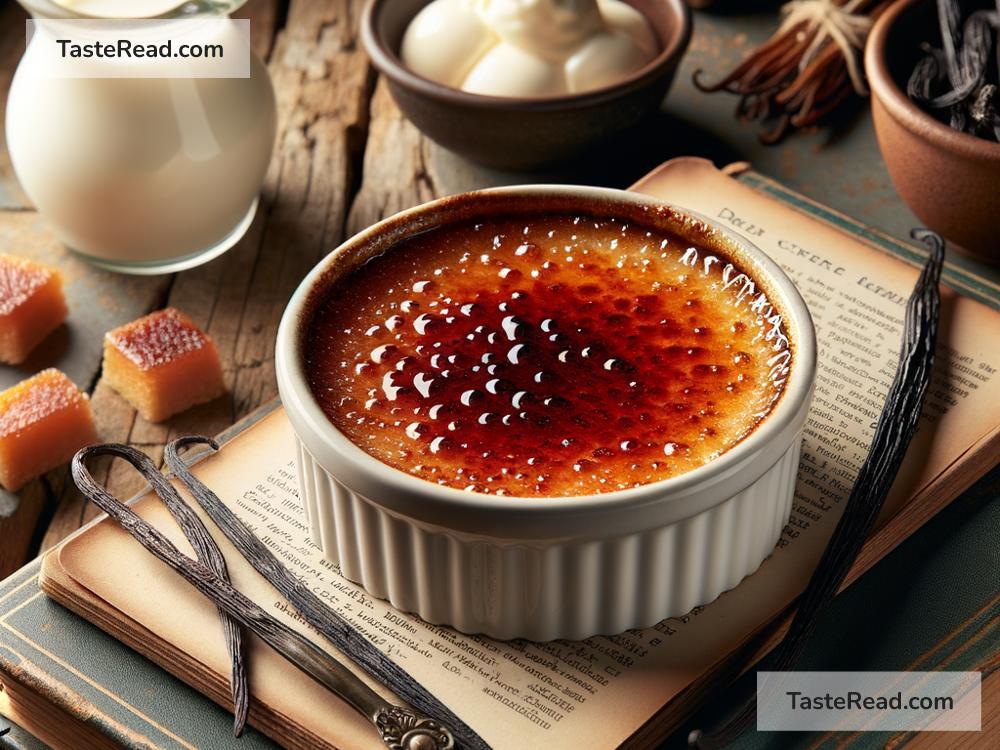The Sweet Tale of French Crème Brûlée
Crème brûlée—creamy, sweet, and topped with a caramelized sugar crust—is a dessert that feels as elegant as it tastes. It’s a dish that has captured the hearts of food lovers across the globe. But did you know that its history is filled with mystery, competing claims, and ties to some of Europe’s finest cuisines? Let’s dive into the story of crème brûlée, a dessert that has stood the test of time.
What Is Crème Brûlée?
Before we jump into the history, let’s first understand what crème brûlée is. It’s a rich custard dessert made with a few simple ingredients: cream, egg yolks, sugar, and vanilla. What makes crème brûlée truly unique, though, is its famous caramelized sugar topping. After the custard is chilled, sugar is sprinkled on top and torch-heated until it melts and hardens into a crunchy layer. Breaking through the brittle sugar crust with a spoon to reveal the silky custard underneath is one of life’s small, satisfying pleasures.
Crème brûlée is known as one of the ultimate French desserts. The name itself is French, meaning “burnt cream,” and true enough—the sugar topping, caramelized with fire, is the dessert’s defining feature. But interestingly, the origins of crème brûlée are not exclusively French.
Where Did Crème Brûlée Come From?
The story of crème brûlée is not straightforward. Food historians disagree about where the dessert first appeared. France, England, and even Spain all claim to have invented it. Let’s explore the three contenders in this sweet competition:
The French Claim
The French are most commonly credited with popularizing crème brûlée as we know it. The dessert began to appear in French recipes in the 17th century. One of the earliest mentions of it was in the cookbook of François Massialot, a famous French chef who served royalty, including Louis XIV. Massialot’s cookbook, published in 1691, had a recipe for “crème brûlée.” However, there was one notable difference—it was the same creamy custard, but the sugar topping was caramelized using a hot iron rather than a flame.
Massialot’s recipe brought attention to the dish in France, and over time, crème brûlée evolved into the iconic dessert we enjoy today. By the early 20th century, the dish became a symbol of French culinary sophistication, served in upscale restaurants, particularly in Paris.
The English Claim
While the French often get the credit, England also has a stake in crème brûlée’s history. The English version of the dessert, known as “burnt cream,” was reportedly served at Trinity College in Cambridge as early as the late 17th century—around the same time Massialot was writing about it. According to popular legend, the college chefs created a custard dessert and added a caramelized sugar topping with a branding iron.
Interestingly, “Trinity burnt cream” became a specialty at the college, and it remains a cherished tradition in Cambridge today. Supporters of the English origin story believe that burnt cream spread from Cambridge to other parts of Europe, leading to what we now call crème brûlée.
The Spanish Connection
Spain, too, has its own version of this dessert, called “crema catalana.” This dish dates back even earlier than the French or English versions, as it was reportedly made in the 14th century in Catalonia. Crema catalana is similar to crème brûlée but usually flavored with lemon or cinnamon instead of vanilla. Like the French version, it has a crunchy caramelized sugar crust created with a hot iron or flame.
Although crema catalana has clear Spanish roots, it’s possible that the idea inspired other countries’ desserts, or vice versa. The historical overlap makes it difficult to pinpoint the exact culinary lineage.
The Rise of Modern Crème Brûlée
Despite its complicated beginnings, crème brûlée ultimately became most closely associated with France. By the 19th and 20th centuries, French chefs had perfected the recipe, making it a staple of fine dining menus. The dessert’s luxurious texture and balanced flavors appealed to diners seeking a touch of sophistication.
In the late 20th century, crème brûlée experienced its global renaissance. The dessert gained popularity in the United States during the 1980s, thanks to chefs who introduced French-inspired gourmet cuisine to American restaurants. Crème brûlée became a favorite because of its stunning presentation, simple ingredients, and decadent taste.
Today, crème brûlée remains a classic dessert, found in restaurants and homes worldwide. It’s not just a dish; it’s an experience—the crack of the caramelized sugar, the creamy custard melting on your tongue, and the subtle aroma of vanilla or other flavors.
Why We Love Crème Brûlée
It’s easy to see why crème brûlée continues to charm food lovers. The dessert is simple yet elegant, indulgent yet light. Its versatility also makes it special—you can adapt the recipe to include chocolate, coffee, fruit, or other creative flavors. No matter how it’s made, crème brûlée feels luxurious and timeless.
So, whether you believe it’s French, English, or Spanish, one thing is certain: crème brûlée is a dessert worth celebrating. Its rich history and delightful taste remind us that food is more than just sustenance—it’s a way to connect with culture, tradition, and the joy of eating. Bon appétit!


